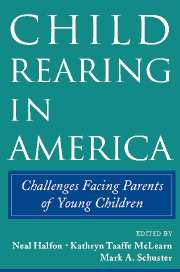Book contents
- Frontmatter
- Contents
- Tables
- Figures
- Contributors
- Acknowledgments
- 1 Introduction and Overview
- PART I CONDITIONS OF FAMILIES WITH YOUNG CHILDREN
- PART II CHILD-REARING PRACTICES
- 4 Meeting the Challenges of New Parenthood: Responsibilities, Advice, and Perceptions
- 5 Reading, Rhymes, and Routines: American Parents and Their Young Children
- 6 Child Discipline in the First Three Years of Life
- 7 Breastfeeding in the United States Today: Are Families Prepared?
- 8 Depressive Symptoms in Parents of Children Under Age 3: Sociodemographic Predictors, Current Correlates, and Associated Parenting Behaviors
- PART III DELIVERY OF HEALTH SERVICES TO MOTHERS AND CHILDREN
- PART IV FUTURE DIRECTIONS AND POLICY IMPLICATIONS
- Index
- References
7 - Breastfeeding in the United States Today: Are Families Prepared?
Published online by Cambridge University Press: 15 July 2009
- Frontmatter
- Contents
- Tables
- Figures
- Contributors
- Acknowledgments
- 1 Introduction and Overview
- PART I CONDITIONS OF FAMILIES WITH YOUNG CHILDREN
- PART II CHILD-REARING PRACTICES
- 4 Meeting the Challenges of New Parenthood: Responsibilities, Advice, and Perceptions
- 5 Reading, Rhymes, and Routines: American Parents and Their Young Children
- 6 Child Discipline in the First Three Years of Life
- 7 Breastfeeding in the United States Today: Are Families Prepared?
- 8 Depressive Symptoms in Parents of Children Under Age 3: Sociodemographic Predictors, Current Correlates, and Associated Parenting Behaviors
- PART III DELIVERY OF HEALTH SERVICES TO MOTHERS AND CHILDREN
- PART IV FUTURE DIRECTIONS AND POLICY IMPLICATIONS
- Index
- References
Summary
Breastfeeding provides an important indication of how a family is organized and functions and it determines the initial nutrition and feeding of an infant child. Although breastfeeding is an age-old and essential behavior for species survival, the practice has declined over this century because of the availability of cow's milk formula. Today, rather than being an automatic behavior for child survival, breastfeeding is a choice that depends on social, family, and health system factors.
We know that more families are making the decision to breastfeed. That choice–one of the first parenting decisions reached by new parents–is a product of a series of complex decisions and adaptations. It is influenced not only by desire and inclination but also by other family, social, and work-place issues. Success is not assured for all families. Indeed, some families are more successful than others in providing this nutritional and nurturing resource to their children.
The Commonwealth Survey provides a unique and important source of independent, nonproprietary data about breastfeeding and its determinants in the United States today, including information about the decision to breastfeed and some of the challenges families face. Much of the available data on breastfeeding in the United States comes from surveys conducted by Ross Laboratories, manufacturers of breastmilk substitutes. These data are used by the Federal government in Department of Health and Human Services annual reports (U.S. Department of Health and Human Services 1998) and by authors who publish in professional and research journals (Ryan 1997).
- Type
- Chapter
- Information
- Child Rearing in AmericaChallenges Facing Parents with Young Children, pp. 178 - 216Publisher: Cambridge University PressPrint publication year: 2002



